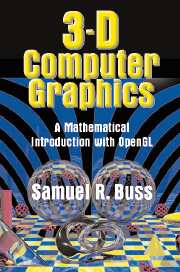Book contents
- Frontmatter
- Contents
- Preface
- I Introduction
- II Transformations and Viewing
- III Lighting, Illumination, and Shading
- IV Averaging and Interpolation
- V Texture Mapping
- VI Color
- VII Bézier Curves
- VIII B-Splines
- IX Ray Tracing
- X Intersection Testing
- XI Radiosity
- XII Animation and Kinematics
- A Mathematics Background
- B RayTrace Software Package
- Bibliography
- Index
- Plate section
II - Transformations and Viewing
Published online by Cambridge University Press: 05 June 2012
- Frontmatter
- Contents
- Preface
- I Introduction
- II Transformations and Viewing
- III Lighting, Illumination, and Shading
- IV Averaging and Interpolation
- V Texture Mapping
- VI Color
- VII Bézier Curves
- VIII B-Splines
- IX Ray Tracing
- X Intersection Testing
- XI Radiosity
- XII Animation and Kinematics
- A Mathematics Background
- B RayTrace Software Package
- Bibliography
- Index
- Plate section
Summary
This chapter discusses the mathematics of linear, affine, and perspective transformations and their uses in OpenGL. The basic purpose of these transformations is to provide methods of changing the shape and position of objects, but the use of these transformations is pervasive throughout computer graphics. In fact, affine transformations are arguably the most fundamental mathematical tool for computer graphics.
An obvious use of transformations is to help simplify the task of geometric modeling. For example, suppose an artist is designing a computerized geometric model of a Ferris wheel. A Ferris wheel has considerable symmetry and includes many repeated elements such as multiple cars and struts. The artist could design a single model of the car and then place multiple instances of the car around the Ferris wheel attached at the proper points. Similarly, the artist could build the main structure of the Ferris wheel by designing one radial “slice” of the wheel and using multiple rotated copies of this slice to form the entire structure. Affine transformations are used to describe how the parts are placed and oriented.
A second important use of transformations is to describe animation. Continuing with the Ferris wheel example, if the Ferris wheel is animated, then the positions and orientations of its individual geometric components are constantly changing. Thus, for animation, it is necessary to compute time-varying affine transformations to simulate the motion of the Ferris wheel.
- Type
- Chapter
- Information
- 3D Computer GraphicsA Mathematical Introduction with OpenGL, pp. 17 - 66Publisher: Cambridge University PressPrint publication year: 2003



